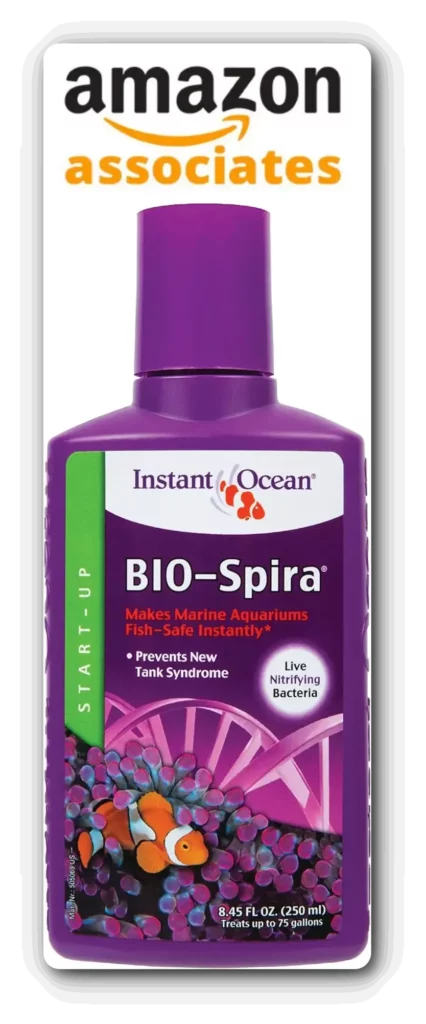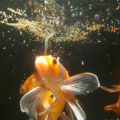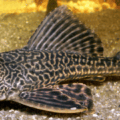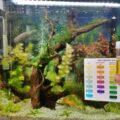Navigating the plethora of information available can be daunting for novice aquarists, but fear not, as we provide clear guidance on this crucial aspect of fish care. From freshwater to saltwater setups, a multitude of questions arises: When is it safe to introduce fish? What factors influence the timing? The key lies in understanding the Nitrogen cycle, a fundamental process in aquarium maintenance. Join us as we unravel the intricacies of cycling a tank, exploring both natural and accelerated methods to establish a healthy environment for your aquatic companions.

Like any other beginner, when I was first setting up an aquarium, I started looking for information on when it is appropriate to add fish to my new tank.
Back then there were limited online sources and the advice of salespeople at pet stores would often oppose what experienced aquarists would suggest.
Whether you’re starting a freshwater or a saltwater aquarium, many questions quickly arise:
What happens if you put your new betta into your tank right away? What if it’s a hardier cold-water fish such as goldfish?
You can actually add a fish 24 hours after setting up the aquarium. However, you can’t do it safely unless you also introduce beneficial bacteria to the system.
Essentially, how long you have to wait before adding fish depends on establishing something called “a Nitrogen cycle” and the method you use to do it.
But what does “cycling” a tank even mean and why is it so important when discussing the addition of fish to a new aquarium?
Luckily, I can help, so let’s dig in.
When to add fish to a new aquarium?
When setting up a new aquarium, you add the substrate and ornaments, install the filtration system and heater, fill the tank with water, and it’s time to put the fish in, right?
Actually, you can’t do that right away because of one very essential condition that needs to be fulfilled:
When there are fish in an aquarium, they generate waste which breaks down into ammonia which is toxic to your tank’s inhabitants. However, there are bacteria strains that convert deadly ammonia and other Nitrogen compounds to less harmful particles that won’t damage your fish and invertebrates.
These compounds are measured in ppm (parts per million) and the process itself is called cycling because it establishes a working Nitrogen cycle.
That being said, here’s when to add fish to a new tank:
Live fish can be added to a new tank only when the aquarium has a working Nitrogen cycle. The natural Nitrogen cycle typically becomes fully functional up to 140 days after starting the tank.
A cycled fish tank has established bacterial colonies that convert ammonia to Nitrite, and then Nitrite to the relatively safe Nitrate.
A fully cycled aquarium has the following water parameters: 0 ppm of ammonia, 0 ppm of Nitrite, and 10 or more ppm of Nitrate. With the fastest cycling methods which usually require the help of supplements, these parameters can be reached in a week or two.
Once you get the target readings, you can safely put fish in because ammonia would be instantly converted.
Author’s note: Since even 1 ppm of ammonia can be dangerous to live creatures you should be able to measure it accurately. To monitor the water parameters I recommend using a reliable liquid test kit.
The Master Test Kit by API is very accurate and has been the preferred option (you can check it out on Amazon here).
It has different versions for freshwater and saltwater setups, so make sure to pick the right one.
How long does it take to cycle a tank depending on the method used?
The methods of cycling an aquarium can be separated into two categories – natural and unnatural.
The unnatural method results in way faster establishment of the beneficial bacteria colonies needed to maintain the Nitrogen cycle.
That’s because you’re manually adding sources of bacteria that are already established. These could be:
- Bottled bacteria that are already in high numbers.
- Filter media or substrate from an existing, already established tank.
Beneficial bacteria inhabit surfaces such as the ones on aquarium filter media or the substrate. I’m assuming that if you’re asking this question you don’t have an established aquarium laying around so I’ll keep the focus on the bottled bacteria.
On the other hand, the natural method doesn’t involve boosting the process with the addition of bacteria.
It revolves around the natural establishment of beneficial bacterial colonies, but it takes a lot more time:
Cycling a tank with some sort of bottled bacteria takes around 2 weeks. If you start from scratch, by following the natural cycling method, it will take anywhere between 6 and 10 weeks.
I personally don’t like waiting 2 months before I can add fish to my aquariums so I usually use a supplement.
Anyway, no matter which method you choose, to start the Nitrogen cycle you need to add a source of ammonia, such as:
- A pinch of fish food.
- Plain ammonia.
- A small hardy fish (fish-in cycle).
- Plants – decaying plant matter will also turn into ammonia.
Fish-in cycle: the Basics
The best way to perform fish-in cycling involves the addition of bottled bacteria.
Though the cycling itself will take up to 2 weeks, you should add fish to the tank 24 hours after setting up the aquarium since it will be the system’s source of ammonia.
I’ve found that if you follow the rule of adding one small species of fish per 10 gallons of water it should be fine. I do not recommend performing fish-in cycling in tanks that hold less than 10 gallons of water.
Such fish tanks are susceptible to violent water parameter swings which can stress the cycling fish and impair its health.
Here’s what happens when you cycle a tank with fish and bottled bacteria:
- After you pour the liquid with bacteria into the tank you should add the fish.
- Your pet will start generating some waste.
- The added nitrifying bacteria will break down the fish waste, without allowing ammonia and nitrite levels to go too high.
With fish-in cycling, it has been my experience that it’s best to introduce fish that won’t generate too much waste. This allows me to have more control over the whole process.
For example, goldfish are known for being quite messy, so the freshly added bacteria may not be able to handle the pollution timely.
Therefore I recommend using hardy beginner fish such as platies or guppies which do not produce as much waste.
Anyway, when it comes to bottled bacteria – a great product that I’ve successfully used numerous times for freshwater fish tanks is the Tetra SafeStart Plus (Amazon.com link). To reinforce saltwater and reef aquarium cycling, I recommend Instant Ocean’s BIO-Spira.


There are other options out there and I’ve reviewed some of them but these two have shown the best results for me.
Author’s Note: I’ve been asked whether it’s possible to add live aquatic plants before the tank is cycled. Actually, you can put a plant inside your aquarium right away.
Doing so may also make the cycling process even safer for fish.
Plants absorb some of the ammonia during the day, which lowers the chances of sudden ammonia spikes in both fish-in and fishless cycling.
Anyway, for those who’re interested in adding their fish faster:
I have a post where I compare Api Quick Start vs. Tetra SafeStart in which you can find a step-by-step guide on how to use bottled bacteria for fish-in aquarium cycling.
There, I’ve also mentioned the needed dosages and what else to expect when cycling a tank with such products.
Fishless cycling
With all being said, many aquarists are against cycling with live fish.
After all, you’re introducing your pet to an environment that isn’t ideal which may stress it out.
With the fishless method, you need to add a source of pure ammonia or other organic matter that would eventually turn into ammonia.
Obviously, when performing a natural fishless cycle, you should only add fish after the whole 10 weeks have passed or when you achieve the right water parameters.
I’m not a fan of this method because you can’t control what amount of beneficial nitrifying bacteria your tank harbors.
Eventually, upon the addition of new fish it could turn out the bacteria are too few and you risk seeing elevated ammonia.
With the fish-in cycle, you’re letting your tank naturally adjust to the amount of waste your pet fish are producing.
Either way, I recommend using bottled bacteria if you want to speed the process up.
Author’s note: I’ve set up many aquariums through fish-in cycling, and their inhabitants had long and happy lives. Furthermore, in some situations, the fish-in cycle is the only option.
For example, beginners would often contact me because they’ve already purchased a Betta or a goldfish in a bag from the pet store.
These people didn’t have any idea that they needed to cycle their new fish tanks before adding the fish.
Unfortunately, most of them were ill-advised by their local fish store.
Anyway, a fish can feel somewhat comfortable in a bag for up to 8 hours and can survive in it for 24 to 48 hours, depending on the amount of oxygen added to the bag.
Therefore, in this situation, putting the fish into the tank after the addition of bottled bacteria is the only way to go if it’s already after the fact.
Just keep in mind that regular water parameter testing is essential throughout the process of cycling a tank, and even more so when there are live fish inside.
Important: Ammonia readings above 2.5 ppm are harmful to both your fish and bacteria. Don’t add any fish to a tank with ammonia readings that are this high.
Perform a water change to lower the ammonia first, and then continue with the addition of bottled bacteria and fish.
How to safely add your fish to their new tank?

Before you start adding any new pets to your new tank, you should use a test kit to measure its water parameters.
A fully cycled aquarium shouldn’t have any ammonia or nitrite, and, ideally, it should contain less than 10 ppm of the less harmful Nitrate.
If your water is clean, you can proceed with transferring your pets to their new aquatic home.
Here’s one method to introduce your new fish to the aquarium, just follow these five simple steps:
- Secure the fish bag at the edge of your aquarium.
- Fill a third of the fish bag with aquarium water and let it sit for 10 minutes.
- Refill the fish bag with aquarium water and wait for another ten minutes.
- Check if the temperature in the water bag is the same as in the aquarium.
- Scoop the fish with the net, then gently place it in the aquarium water.
Author’s note: Make sure to throw out the bag water from the store once you’ve transferred all of your fish to their new home. You shouldn’t pour it in the aquarium since this can contaminate its water.
How often can you add new fish to a cycled tank?
So you have your fish tank cycled and you’ve added its first inhabitants.
However, you’re already ogling new fish species that you’ve researched will do well within your aquarium’s community.
The frequency of adding new fish to your tank actually depends on the size of your tank and the size of the fish you’re adding.
The safest way would be to add 5 inches worth of fish for every 10 gallons of water per week. If you add fish more often, the established bacteria may not be able to handle the increased amount of fish waste.
Adding too many fish at once is something we’re all guilty of at one point or another and it can lead to an ammonia spike that may cause fish deaths.
This may also happen if the fish you’re adding generates a lot of waste – for example, goldfish.
Following these thoughts, it’s actually better and easier to have a large tank, instead of the common 5-gallon one.
Though there are some fish that can safely go into a 5-gallon tank, usually a larger one gives more room for error.
Anyway, to avoid messing up the established Nitrogen cycle, I recommend adding bottled bacteria when putting new fish into your tank.
If you’re dealing with a freshwater aquarium then both API Quick Start and Tetra SafeStart Plus are great products for such occasions.
My Words of Advice
I hope that you found this guide helpful and learned a thing or two about how to safely load your new tank with your favorite pet fish.
If you’re a beginner in the hobby, it may seem that starting a new aquarium is too complicated.
I assure you – it isn’t. Once you understand the concept behind the Nitrogen cycle and how water parameters affect your fish, it all starts to make sense.
If you have any unanswered questions, you can post a comment down below or check some of my other guides for beginners.
Everyone needs to start from somewhere.












If I’m adding a group of community fish to a tank should I add them all at once or split them up into separate groups to avoid messing up the balance? I have one fish and a few snails but the only other thing I’m adding is a group of 8 or so rasbora and a couple shrimp. Would adding the shrimp then waiting a week allow my tank to handle all 8 rasbora at once or will they be ok with just 4 for a week or so?
Hello , we got a 5 gallon tank for our kids first pets. We attempted forts with 2 glow fish from pets mart and they were good. Then the filter started to make a grinding sound and within an hour both died ( they were in the tank for 2 days ) needless to say we were very sad. When we first got them I washed everything. Conditioned the water for the time that it said . Put the fish in the tank still in the bag for 30 min like the worker told us . Then release them . Feed them and they were ok . Then at night the sound of the filter started and they died . We went wanted to get get a new tank all together and we tested the water at the store also . They said the water was great. We ended up getting the same size tank but with a different kind of filter. We got it home did the same progress only this time we didn’t take the fish. We got two snails since they said they were stronger. Snails are doing good. I am feeding them like fish. So se are wondering if we can get the fish in the tank by now . And if you know what we did wrong with the first 2 . Thank you
I was given a fish with no notice so I brought a tank and asked all I needed although I was not told about cycling the tank I’ve had the fish for 3 days now. The water is cloudy and I’ve done 50% water change. Just wondering if I could add the bpttled live bacteria with the fish in the tank at the same time or would I have to remove it?
It’s a baby discus btw
Hello Hayley,
You can add the bottled bacteria right away, no need to remove the fish from your new tank.
However, let me just say that if it’s an actual discus and you have no prior experience with fishkeeping I’d recommend returning the baby to the pet store. Discus are advanced-level fish and are rather fragile. Whoever gifted you the fish did it a disservice. Please give it a thought.
Whatever your decision is – Good luck!
Momchil